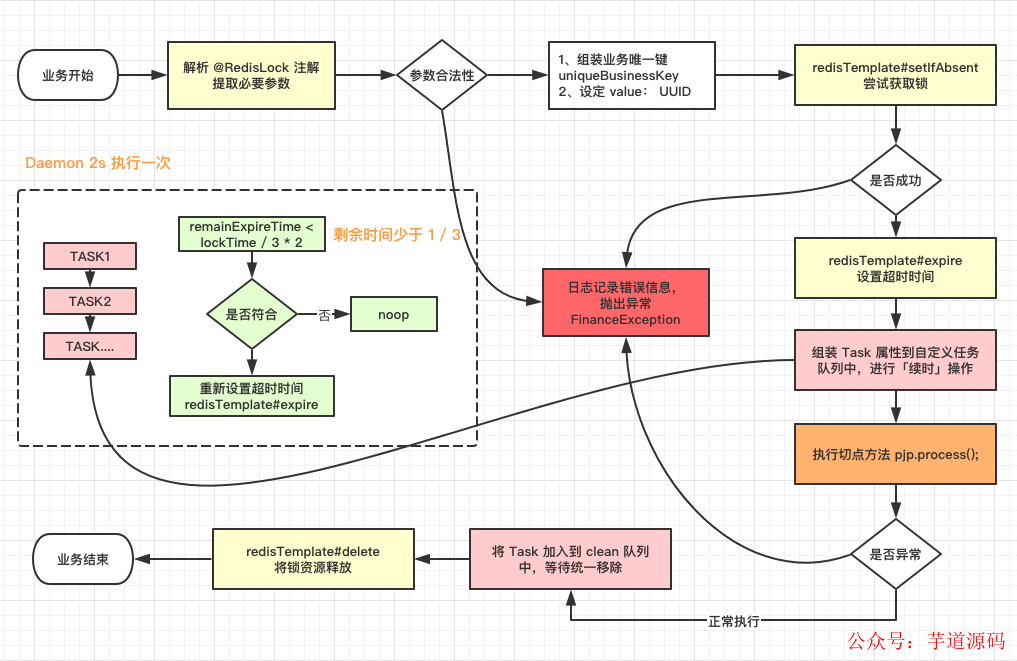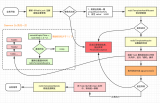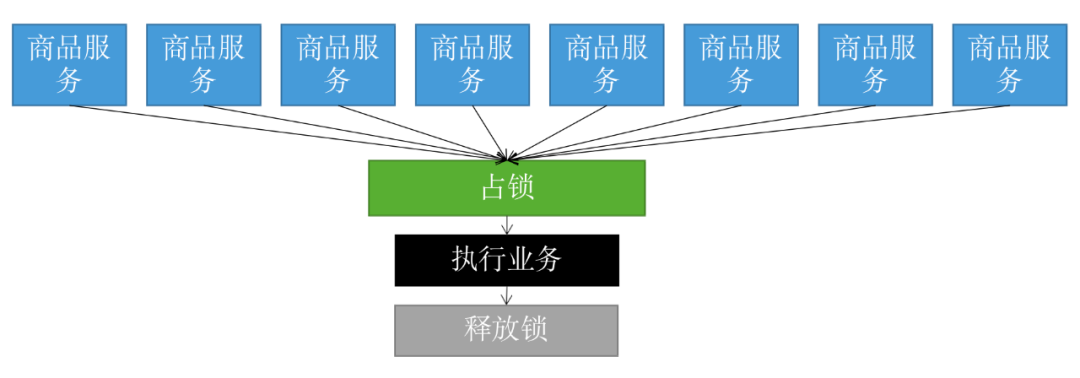一、业务背景
有些业务请求,属于耗时操作,需要加锁,防止后续的并发操作,同时对数据库的数据进行操作,需要避免对之前的业务造成影响。
二、分析流程
使用 Redis 作为分布式锁,将锁的状态放到 Redis 统一维护,解决集群中单机 JVM 信息不互通的问题,规定操作顺序,保护用户的数据正确。
梳理设计流程
新建注解 @interface,在注解里设定入参标志
增加 AOP 切点,扫描特定注解
建立 @Aspect 切面任务,注册 bean 和拦截特定方法
特定方法参数 ProceedingJoinPoint,对方法 pjp.proceed() 前后进行拦截
切点前进行加锁,任务执行后进行删除 key
核心步骤:加锁、解锁和续时
加锁
使用了 RedisTemplate 的 opsForValue.setIfAbsent 方法,判断是否有 key,设定一个随机数 UUID.random().toString,生成一个随机数作为 value。
从 redis 中获取锁之后,对 key 设定 expire 失效时间,到期后自动释放锁。
按照这种设计,只有第一个成功设定 Key 的请求,才能进行后续的数据操作,后续其它请求由于无法获得资源,将会失败结束。
超时问题
担心 pjp.proceed() 切点执行的方法太耗时,导致 Redis 中的 key 由于超时提前释放了。
例如,线程 A 先获取锁,proceed 方法耗时,超过了锁超时时间,到期释放了锁,这时另一个线程 B 成功获取 Redis 锁,两个线程同时对同一批数据进行操作,导致数据不准确。
解决方案:增加一个「续时」
任务不完成,锁不释放:
维护了一个定时线程池 ScheduledExecutorService,每隔 2s 去扫描加入队列中的 Task,判断是否失效时间是否快到了,公式为:【失效时间】<= 【当前时间】+【失效间隔(三分之一超时)】
/** *线程池,每个JVM使用一个线程去维护keyAliveTime,定时执行runnable */ privatestaticfinalScheduledExecutorServiceSCHEDULER= newScheduledThreadPoolExecutor(1, newBasicThreadFactory.Builder().namingPattern("redisLock-schedule-pool").daemon(true).build()); static{ SCHEDULER.scheduleAtFixedRate(()->{ //dosomethingtoextendtime },0,2,TimeUnit.SECONDS); }
三、设计方案
经过上面的分析,同事小设计出了这个方案:
 图片
图片
前面已经说了整体流程,这里强调一下几个核心步骤:
拦截注解 @RedisLock,获取必要的参数
加锁操作
续时操作
结束业务,释放锁
四、实操
之前也有整理过 AOP 使用方法,可以参考一下
相关属性类配置
业务属性枚举设定
publicenumRedisLockTypeEnum{
/**
*自定义key前缀
*/
ONE("Business1","Test1"),
TWO("Business2","Test2");
privateStringcode;
privateStringdesc;
RedisLockTypeEnum(Stringcode,Stringdesc){
this.code=code;
this.desc=desc;
}
publicStringgetCode(){
returncode;
}
publicStringgetDesc(){
returndesc;
}
publicStringgetUniqueKey(Stringkey){
returnString.format("%s:%s",this.getCode(),key);
}
}
任务队列保存参数
publicclassRedisLockDefinitionHolder{
/**
*业务唯一key
*/
privateStringbusinessKey;
/**
*加锁时间(秒s)
*/
privateLonglockTime;
/**
*上次更新时间(ms)
*/
privateLonglastModifyTime;
/**
*保存当前线程
*/
privateThreadcurrentTread;
/**
*总共尝试次数
*/
privateinttryCount;
/**
*当前尝试次数
*/
privateintcurrentCount;
/**
*更新的时间周期(毫秒),公式=加锁时间(转成毫秒)/3
*/
privateLongmodifyPeriod;
publicRedisLockDefinitionHolder(StringbusinessKey,LonglockTime,LonglastModifyTime,ThreadcurrentTread,inttryCount){
this.businessKey=businessKey;
this.lockTime=lockTime;
this.lastModifyTime=lastModifyTime;
this.currentTread=currentTread;
this.tryCount=tryCount;
this.modifyPeriod=lockTime*1000/3;
}
}
设定被拦截的注解名字
@Retention(RetentionPolicy.RUNTIME)
@Target({ElementType.METHOD,ElementType.TYPE})
public@interfaceRedisLockAnnotation{
/**
*特定参数识别,默认取第0个下标
*/
intlockFiled()default0;
/**
*超时重试次数
*/
inttryCount()default3;
/**
*自定义加锁类型
*/
RedisLockTypeEnumtypeEnum();
/**
*释放时间,秒s单位
*/
longlockTime()default30;
}
核心切面拦截的操作
RedisLockAspect.java 该类分成三部分来描述具体作用
Pointcut 设定
/**
*@annotation中的路径表示拦截特定注解
*/
@Pointcut("@annotation(cn.sevenyuan.demo.aop.lock.RedisLockAnnotation)")
publicvoidredisLockPC(){
}
Around 前后进行加锁和释放锁
前面步骤定义了我们想要拦截的切点,下一步就是在切点前后做一些自定义操作:
@Around(value="redisLockPC()")
publicObjectaround(ProceedingJoinPointpjp)throwsThrowable{
//解析参数
Methodmethod=resolveMethod(pjp);
RedisLockAnnotationannotation=method.getAnnotation(RedisLockAnnotation.class);
RedisLockTypeEnumtypeEnum=annotation.typeEnum();
Object[]params=pjp.getArgs();
StringukString=params[annotation.lockFiled()].toString();
//省略很多参数校验和判空
StringbusinessKey=typeEnum.getUniqueKey(ukString);
StringuniqueValue=UUID.randomUUID().toString();
//加锁
Objectresult=null;
try{
booleanisSuccess=redisTemplate.opsForValue().setIfAbsent(businessKey,uniqueValue);
if(!isSuccess){
thrownewException("Youcan'tdoit,becauseanotherhasgetthelock=-=");
}
redisTemplate.expire(businessKey,annotation.lockTime(),TimeUnit.SECONDS);
ThreadcurrentThread=Thread.currentThread();
//将本次Task信息加入「延时」队列中
holderList.add(newRedisLockDefinitionHolder(businessKey,annotation.lockTime(),System.currentTimeMillis(),
currentThread,annotation.tryCount()));
//执行业务操作
result=pjp.proceed();
//线程被中断,抛出异常,中断此次请求
if(currentThread.isInterrupted()){
thrownewInterruptedException("Youhadbeeninterrupted=-=");
}
}catch(InterruptedExceptione){
log.error("Interruptexception,rollbacktransaction",e);
thrownewException("Interruptexception,pleasesendrequestagain");
}catch(Exceptione){
log.error("hassomeerror,pleasecheckagain",e);
}finally{
//请求结束后,强制删掉key,释放锁
redisTemplate.delete(businessKey);
log.info("releasethelock,businessKeyis["+businessKey+"]");
}
returnresult;
}
上述流程简单总结一下:
解析注解参数,获取注解值和方法上的参数值
redis 加锁并且设置超时时间
将本次 Task 信息加入「延时」队列中,进行续时,方式提前释放锁
加了一个线程中断标志
结束请求,finally 中释放锁
续时操作
这里用了 ScheduledExecutorService,维护了一个线程,不断对任务队列中的任务进行判断和延长超时时间:
//扫描的任务队列 privatestaticConcurrentLinkedQueueholderList=newConcurrentLinkedQueue(); /** *线程池,维护keyAliveTime */ privatestaticfinalScheduledExecutorServiceSCHEDULER=newScheduledThreadPoolExecutor(1, newBasicThreadFactory.Builder().namingPattern("redisLock-schedule-pool").daemon(true).build()); { //两秒执行一次「续时」操作 SCHEDULER.scheduleAtFixedRate(()->{ //这里记得加try-catch,否者报错后定时任务将不会再执行=-= Iterator iterator=holderList.iterator(); while(iterator.hasNext()){ RedisLockDefinitionHolderholder=iterator.next(); //判空 if(holder==null){ iterator.remove(); continue; } //判断key是否还有效,无效的话进行移除 if(redisTemplate.opsForValue().get(holder.getBusinessKey())==null){ iterator.remove(); continue; } //超时重试次数,超过时给线程设定中断 if(holder.getCurrentCount()>holder.getTryCount()){ holder.getCurrentTread().interrupt(); iterator.remove(); continue; } //判断是否进入最后三分之一时间 longcurTime=System.currentTimeMillis(); booleanshouldExtend=(holder.getLastModifyTime()+holder.getModifyPeriod())<= curTime; if (shouldExtend) { holder.setLastModifyTime(curTime); redisTemplate.expire(holder.getBusinessKey(), holder.getLockTime(), TimeUnit.SECONDS); log.info("businessKey : [" + holder.getBusinessKey() + "], try count : " + holder.getCurrentCount()); holder.setCurrentCount(holder.getCurrentCount() + 1); } } }, 0, 2, TimeUnit.SECONDS); }
这段代码,用来实现设计图中虚线框的思想,避免一个请求十分耗时,导致提前释放了锁。
这里加了「线程中断」Thread#interrupt,希望超过重试次数后,能让线程中断 (未经严谨测试,仅供参考哈哈哈哈)
不过建议如果遇到这么耗时的请求,还是能够从根源上查找,分析耗时路径,进行业务优化或其它处理,避免这些耗时操作。
所以记得多打点 Log,分析问题时可以更快一点。
五、开始测试
在一个入口方法中,使用该注解,然后在业务中模拟耗时请求,使用了 Thread#sleep
@GetMapping("/testRedisLock")
@RedisLockAnnotation(typeEnum=RedisLockTypeEnum.ONE,lockTime=3)
publicBooktestRedisLock(@RequestParam("userId")LonguserId){
try{
log.info("睡眠执行前");
Thread.sleep(10000);
log.info("睡眠执行后");
}catch(Exceptione){
//logerror
log.info("hassomeerror",e);
}
returnnull;
}
使用时,在方法上添加该注解,然后设定相应参数即可,根据 typeEnum 可以区分多种业务,限制该业务被同时操作。
测试结果:
2020-04-0414:55:50.864INFO9326---[nio-8081-exec-1]c.s.demo.controller.BookController:睡眠执行前 2020-04-0414:55:52.855INFO9326---[k-schedule-pool]c.s.demo.aop.lock.RedisLockAspect:businessKey:[Business1:1024],trycount:0 2020-04-0414:55:54.851INFO9326---[k-schedule-pool]c.s.demo.aop.lock.RedisLockAspect:businessKey:[Business1:1024],trycount:1 2020-04-0414:55:56.851INFO9326---[k-schedule-pool]c.s.demo.aop.lock.RedisLockAspect:businessKey:[Business1:1024],trycount:2 2020-04-0414:55:58.852INFO9326---[k-schedule-pool]c.s.demo.aop.lock.RedisLockAspect:businessKey:[Business1:1024],trycount:3 2020-04-0414:56:00.857INFO9326---[nio-8081-exec-1]c.s.demo.controller.BookController:hassomeerror java.lang.InterruptedException:sleepinterrupted atjava.lang.Thread.sleep(NativeMethod)[na:1.8.0_221]
我这里测试的是重试次数过多,失败的场景,如果减少睡眠时间,就能让业务正常执行。
如果同时请求,你将会发现以下错误信息:
 图片
图片
表示我们的锁的确生效了,避免了重复请求。
六、总结
对于耗时业务和核心数据,不能让重复的请求同时操作数据,避免数据的不正确,所以要使用分布式锁来对它们进行保护。
再来梳理一下设计流程:
新建注解 @interface,在注解里设定入参标志
增加 AOP 切点,扫描特定注解
建立 @Aspect 切面任务,注册 bean 和拦截特定方法
特定方法参数 ProceedingJoinPoint,对方法 pjp.proceed() 前后进行拦截
切点前进行加锁,任务执行后进行删除 key
本次学习是通过 Review 小伙伴的代码设计,从中了解分布式锁的具体实现,仿照他的设计,重新写了一份简化版的业务处理。对于之前没考虑到的「续时」操作,这里使用了守护线程来定时判断和延长超时时间,避免了锁提前释放。
于是乎,同时回顾了三个知识点:
1、AOP 的实现和常用方法
2、定时线程池 ScheduledExecutorService 的使用和参数含义
3、线程 Thread#interrupt 的含义以及用法(这个挺有意思的,可以深入再学习一下)
审核编辑:刘清
-
AOP
+关注
关注
0文章
40浏览量
11108 -
JVM
+关注
关注
0文章
158浏览量
12238 -
Redis
+关注
关注
0文章
376浏览量
10887
原文标题:使用注解实现redis分布式锁
文章出处:【微信号:芋道源码,微信公众号:芋道源码】欢迎添加关注!文章转载请注明出处。
发布评论请先 登录
相关推荐
如何使用注解实现redis分布式锁!





 使用注解实现redis分布式锁的流程
使用注解实现redis分布式锁的流程











评论